In 2024, you might wonder if Fitbit is still relevant. Despite getting acquired by Google, Fitbit remains one of the most recognizable names in the industry. Fitbit trackers aren’t meant for the most hardcore of athletes, but they’re still excellent devices for tracking overall activity as well as monitoring certain health and wellness metrics like EKGs and blood oxygen levels.
Technology
Ro CEO Zachariah Reitano says the benefits of being a private company are growing

Ro co-founder and CEO Zachariah Reitano said while he’d “never say never” about potentially taking the seven-year-old telehealth company public, he thinks the benefits of being a private company are growing.
Reitano dodged multiple questions from Axios reporter Dan Primack about whether or not the company has plans to IPO in the near term — or in general — at Axios’s BFD event on October 22nd.
“I might give an unsatisfying answer, but the truth is that right now, we are exclusively focused on delivering the highest quality product for our patients,” Reitano said.
Ro has raised more than $1 billion in venture capital from the likes of General Catalyst, Initialized Capital and Torch Capital, among many others. Ro most recently raised a $150 million in a round led by ShawSpring Partners that valued the company at around $6.6 billion.
Reitano’s sentiment is likely one shared by other late-stage startup founders as venture-backed companies continue to stay private longer, according to PitchBook data. Another factor keeping companies private is the rise of the secondaries market as an increasingly common way to give investors and employees some liquidity — although the majority of activity surrounds a handful of companies.
He also talked about the company’s big “uncomfortable bet” on weight loss drugs that became available on the platform in 2023. Ro was founded in 2017 by Rob Schutz, Saman Rahmanian and Reitano as a telehealth company focused on erectile disfunction. The company expanded to more men’s and women’s health categories including hair growth, fertility and skin health. But it has now become well known as a provider of multiple GLP-1s options.
Reitano said the company began developing the program to offer such drugs in 2021 and moved a significant percentage of its resources into the category at the time. It is now one of the fastest growing sectors of its business.
“Providers want patients to have it, and patients desperately want it. Those things have never happened in any drug category before, and so from our perspective, the prevalence and widespread usage of GLP-1s is inevitable,” Reitano said.
He added that the expansion was natural at the time for the company as conditions like obesity impact many of the other health categories the company focuses on including fertility and sexual health conditions like erectile disfunction.
Technology
Why ISRO’s involvement in ESA’s PROBA-3 mission is a milestone- The Week
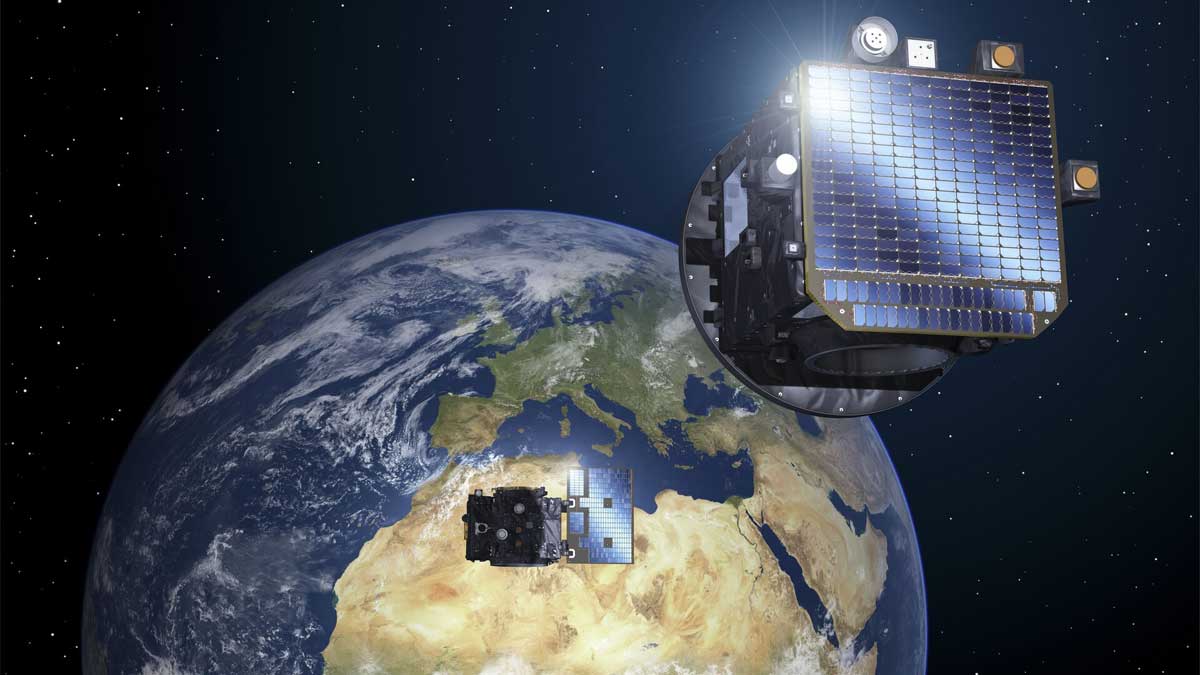
PROBA-3 (Project for On-Board Autonomy-3) is an innovative initiative spearheaded by the European Space Agency (ESA) aimed at revolutionising space observation through advanced formation flying technology. Scheduled for launch in November 2024, this mission exemplifies a significant international collaboration, bringing together expertise and cutting-edge technologies from multiple European countries and the Indian Space Research Organisation (ISRO). The PROBA-3 mission has passed its final test and is now ready to be sent to India, where it will be launched by the ISRO. PROBA-3 will be transported to the Satish Dhawan Space Centre later this month and the mission will be launched using ISRO’s trusted PSLV-XL rocket.
What is the PROBA-3 mission?
PROBA-3 is the ESA’s first mission dedicated to precision formation flying. “In this mission, two satellites will operate together in a coordinated manner, maintaining a set distance and alignment in space as if they were part of a single, large structure. The goal is to test, and demonstrate, advanced technologies for formation flying and conduct experiments related to spacecraft rendezvous the meeting, or docking, of two spacecraft,” said space expert Girish Linganna.
ALSO READ: Solar exploration: A sunrace of significant global missions
The mission will showcase formation flying as part of a major scientific experiment. The two satellites will work together as a single unit to carry out the experiment, demonstrating how closely coordinated satellite systems can function in space. Both the satellites will combine to create a 144-metre-long solar coronagraph, a special tool designed to study the Sun’s faint outer atmosphere, or the corona. A solar coronagraph works by blocking out the bright light from the Sun’s surface, creating an artificial eclipse.
ALSO READ: NISAR, Mars and Venus missions in 2024: Top ISRO projects slated for the Year of Gaganyaan
“The faint corona is usually hidden by the Sun’s intense brightness, but this setup will allow scientists to observe, and analyse, the corona much closer to the Sun’s surface than ever before, providing new insights into solar activity. The coronagraph helps in studying solar activity, such as solar flares and coronal mass ejections which can affect space weather without waiting for an eclipse,” added Linganna.
The core objective of PROBA-3 is to create an artificial eclipse by precisely coordinating two independent satellites. This capability will enable scientists to observe the Sun’s corona, a region typically obscured by the intense brightness of the Sun. By blocking out sunlight, the satellites will facilitate unprecedented studies of solar phenomena, including solar flares and coronal mass ejections. Understanding these phenomena is crucial, as they can have significant effects on space weather, which in turn impacts satellite communications, navigation systems, and power grids on Earth.
“In addition to demonstrating high-precision formation flying, PROBA-3 is set to validate new technologies essential for maintaining the satellites in close proximity. The mission aims to reach Technology Readiness Level 9 (TRL 9), showcasing advancements in metrology systems, control logic, and manoeuvring capabilities. This will allow for precise manoeuvres necessary for the mission’s success and for future space exploration endeavours,” explained Srimathy Kesan, founder and CEO of Space Kidz India, which is into design, fabrication and launch of small satellites, spacecraft and ground systems.
How is PROBA-3 different from other solar observation projects?
A key aspect that sets PROBA-3 apart from traditional solar observation projects is its innovative approach to utilising smaller, agile satellites equipped with advanced sensors. Many conventional solar missions involve large, complex spacecraft, which can be expensive and challenging to manoeuvre. In contrast, PROBA-3’s use of two smaller satellites operating in a highly coordinated formation demonstrates that complex observational tasks can be accomplished efficiently and cost-effectively without the need for oversized equipment. This flexibility paves the way for more versatile missions, allowing space agencies to maximise their scientific output while operating within constrained budgets.
The collaborative nature of the PROBA-3 mission further enhances its significance. It involves contributions from various ESA member states, including France, Belgium, and the Netherlands, alongside ISRO. This international partnership not only facilitates the sharing of technological expertise but also fosters a collaborative spirit in addressing common challenges in space exploration. Such partnerships are increasingly important as space missions become more ambitious and complex, requiring a diverse range of skills and knowledge.
As the launch date approaches, extensive testing and simulations are being conducted to ensure the mission’s success. The excitement surrounding PROBA-3 reflects the scientific community’s anticipation of potential breakthroughs, particularly in solar physics and its implications for understanding space weather. The data collected during this mission could transform our understanding of solar activity, leading to improved forecasting models for space weather events. This is especially crucial for mitigating risks to both civilian and military satellite operations and for protecting critical infrastructure on Earth from the effects of solar storms.
“By creating an artificial eclipse, this mission promises to enhance our understanding of the Sun’s behaviour and its broader impacts on the solar system. This mission not only advances our knowledge of the cosmos but also sets a precedent for future collaborations in space exploration, paving the way for a new generation of scientists and explorers dedicated to unraveling the mysteries of our universe,” said Kesan.
As part of the mission the occulter spacecraft is a satellite designed to block, or ‘occlude’, the Sun’s bright light so that other instruments, such as the coronagraph, can get a clearer view of the Sun’s outer atmosphere (the corona). By positioning itself in front of the Sun, it creates an artificial eclipse, making it easier to study the faint details of the corona without interference from the Sun’s intense brightness.
Both the coronagraph spacecraft (weighing 340-kg) and the occulter spacecraft (weighing 200kg) will operate in a high Earth orbit, taking 19.7 hours to complete one orbit. At its highest point, the orbit will reach 60,530km and, at its closest point, it will be 600km above Earth. The primary instrument on board is an external coronagraph. The mission’s communication will be supported by an antenna located at Santa Maria in the Azores, with a ground station in Redu, Belgium.
Technology
Best Router Deals: Save on Mesh Networks and Wi-Fi 6 Routers
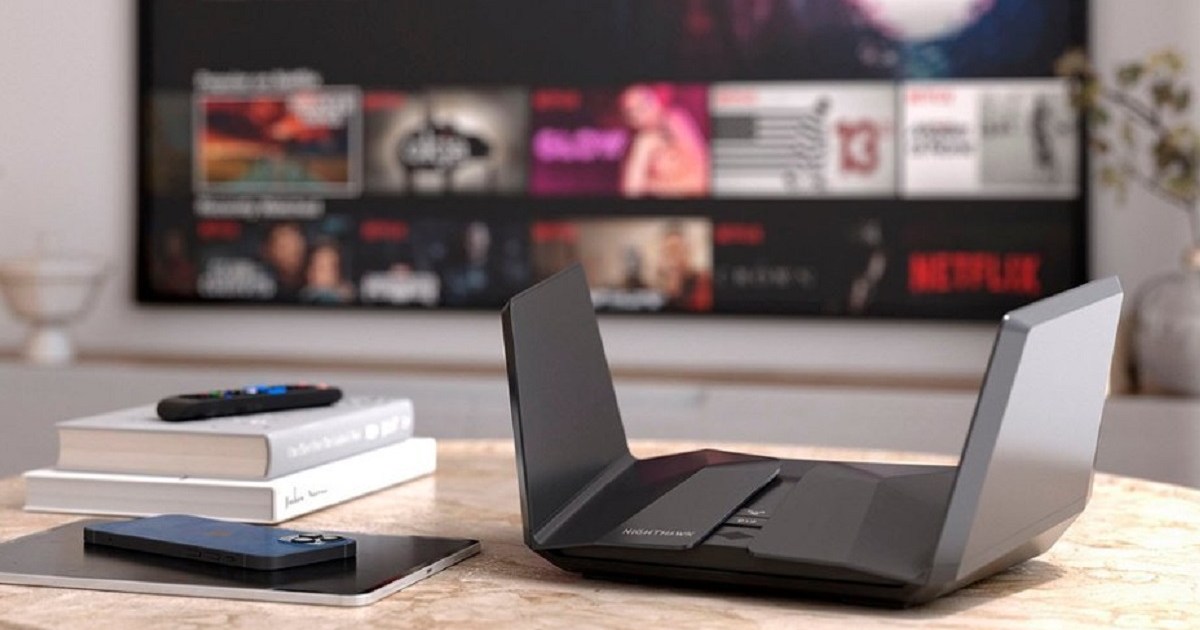
These days, almost every single device out there can connect to the internet, and if you have an older router, then you may be struggling with things like slow speed or the connection dropping regularly. Luckily, a modern router can fix a lot of these issues, especially those that come with the latest Wi-Fi 6 standard and later, since those are made specifically to handle multiple connections. Not only that, but another great option is to grab a mesh router system, which is great if you want coverage for a larger house without having to create access points or use repeaters.
Of course, there are a lot of routers to pick from out there, and if you don’t have a lot of tech-savvy, it can be overwhelming. That’s why we’ve gone out and found our favorite router deals that will give you the best bang for your buck, and that includes mesh router deals too. So if you’ve just picked up some smart home devices from Google Nest deals or Amazon Echo deals, or you need to lower your ping so you can enjoy gaming PC deals and gaming console deals to their fullest, check out the options below.
Best Router Deals
Linksys AX3000 Mesh — $80 $180 56% off
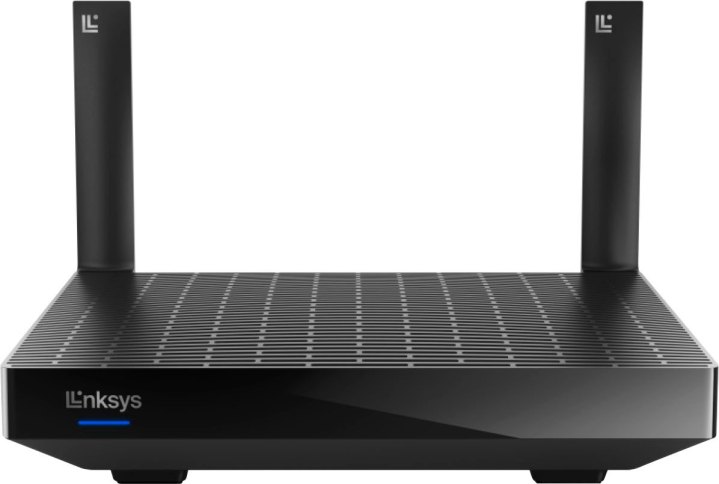
Another great option that can run at the combined speed of 3Gbps, the Linksys AX3000 Mesh has a bit more coverage, up to 2,000 square feet, and is a solid option if you need a bit more performance out of your router. It follows the Wi-Fi 6 standard and can connect up to 30 devices, which should be more than enough for the average home, especially if you use a smart bridge or smart hub for your smart home devices. Also, one benefit of the Linksys AX3000 Mesh is that you can also use it as a mesh system if you buy more than one. It’s worth noting that the only way to get this deal is if you have a My Best Buy Plus or Total subscription.
TP-Link Archer AX3000 — $111 $130 15% off
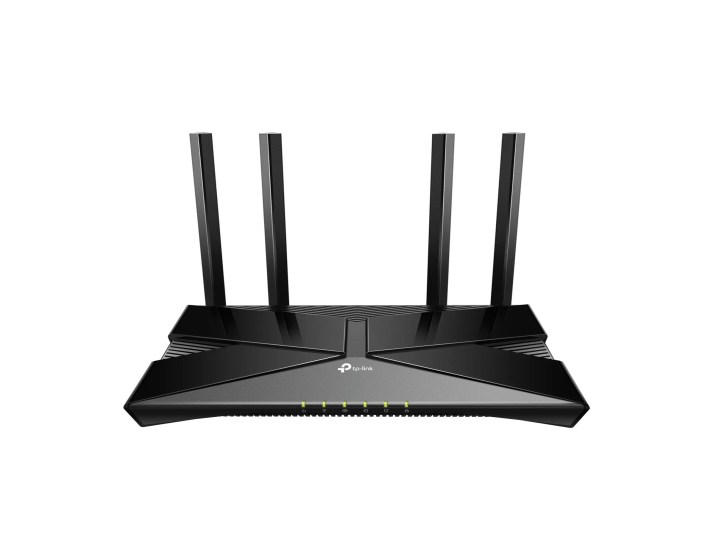
Upgrading to the newer Wi-Fi 6 standard doesn’t have to cost an arm and a leg, especially if you aren’t planning to use it for anything as intense as gaming, which is where the TP-Link Archer AX3000 comes in. It can hit a combined speed of 3Gbps over its two bands and will work wonderfully if you mostly plan to use it to stream content or connect your tablet and phone. It also comes with OFDMA technology, which essentially lets you connect to a lot of devices without experiencing issues, so if you have a lot of smart home devices, this will work great for that too.
Linksys Hydra Pro AXE6600 — $150 $280 46% off
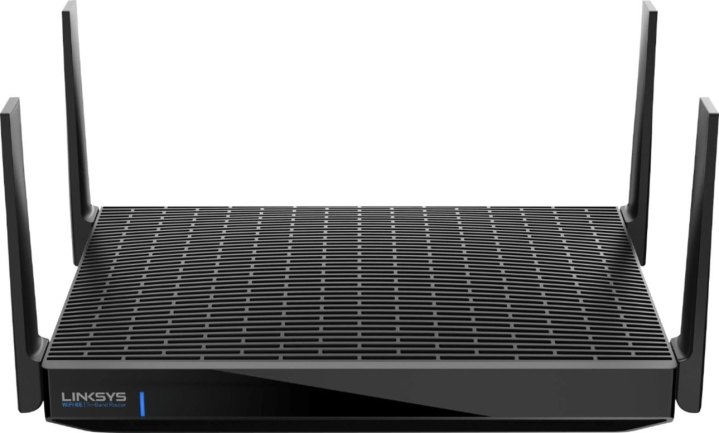
If you want to get the latest Wi-Fi standard, that’s going to be Wi-Fi 6E, which is optimized for connecting with lots of devices using MU-MIMO technology so that you can connect up to a whopping 55 devices at the same time. Not only that, but this comes with a 5 Gigabit WAN port, so its also another great option if you rely heavily on your network for sharing files or watching content on something like a Plex server. That said, coverage isn’t as expansive as some of the cheaper options, coming out to around 2,700 square feet, which is still pretty good if we’re being honest.
ASUS AX5700 — $205 $250 20% off
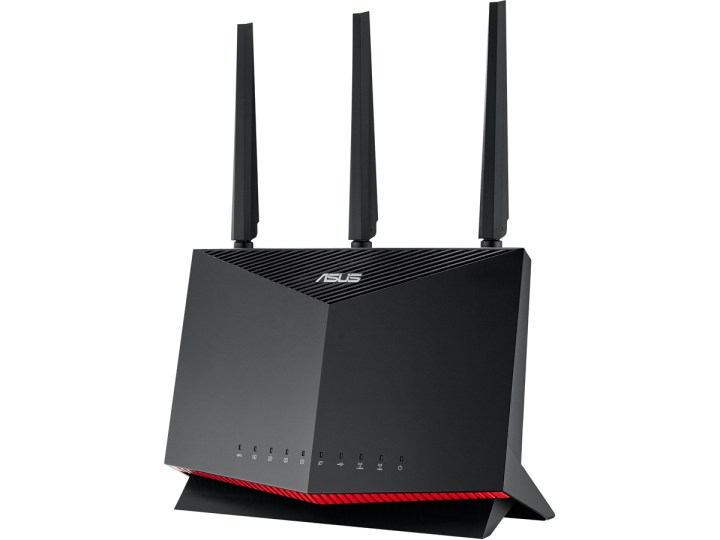
If you have a larger home and need a lot more coverage, then you’ll want to go for the ASUS AX5700, which has a massive 5,000 square-foot coverage and is one of the biggest you’ll find on the market. It can go up to 6000 Mbps combined across all its bands, and even better, it has a 2.5 Gigabit ethernet port, so if you heavily rely on something like a network-attached storage, this is a solid solution. It’s also a great router if you want to game, since it can prioritize gaming connections to help keep lag and other forms of latency down.
ASUS ROG Rapture GT-AX11000 Pro — $327 $400 18% off
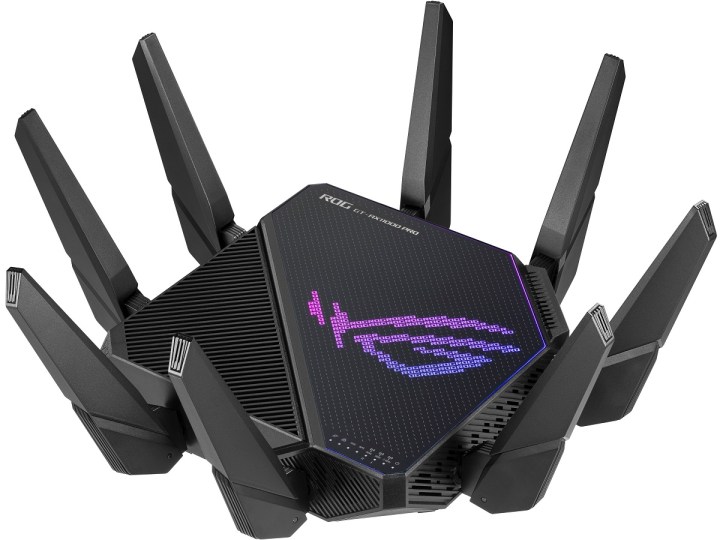
If you take your gaming very seriously, then you may want to consider going for the ASUS ROG Rapture GT-AX11000 Pro, which certainly looks like it’s come out of a sci-fi game set in a few hundred years. It has a very impressive 5,400 square feet of coverage, which even rivals some mesh routes, can handle a whopping combined speed of 11,000 Mbps, and even has a 2.5 Gigabit ethernet port, so it can go incredibly fast. It’s also optimized to provide a clear signal and try its best to decrease latency so that you have a smooth gaming experience. It is worth noting that you need a My Best Buy Plus membership to get this discount.
Best Mesh Router Deals
TP-Link Deco M5 Mesh WiFi System (2-pack) — $99 $115 13% off

A good starter set of mesh routers is this 2-pack of TP-Link Deco M5 which can cover an impressive 3,800 square feet and is great if you have a plan that can reach up to 450Mbps. Even better, each of the Deco M5s comes with a 2.5 Gigbit ethernet port, so you can get faster transfer speeds inside your home, which is very handy. Beyond that, this mesh system can connect up to 100 devices which should be more than enough for the average home, even one that is chock full of smart home devices.
TP-Link Deco X20 WiFi 6 Mesh System (3-pack) — $140 $180 22% off
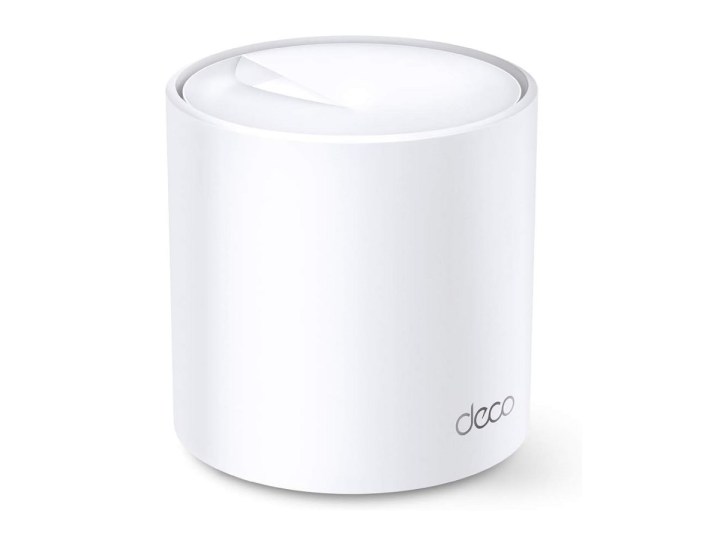
If you want to ensure fast wifi speeds, these TP-Link Deco X20s support wired ethernet backhaul, and with a 2.5 Gigabit ethernet port, you can keep your Wi-Fi speeds pretty fast. In terms of coverage, this 3-pack can cover 5,800 square feet and can connect to a whopping 150 different devices, so it’s very forward-facing if you plan to add a bunch of extra smart devices.
Linksys Atlas Pro 6 (3-pack) — $228 $350 20% off

Luckily, if you’re trying to cover a huge area, you don’t need to spend several hundred dollars, as this three-pack from Linksys can manage a whopping 8,100 square feet of coverage. It has a combined top-speed of 5.4Gbps for Wi-Fi and 1Gbps for wired, although it’s worth noting you won’t likely be getting anywhere near those Wi-Fi numbers, especially as you get further away from the base stations. Even so, if you have a gigabit internet connection, you should be able to use it to capacity on this mesh network.
NETGEAR Orbi Whole Home Tri-band Mesh WiFi 6 System (2-pack) — $399 $450 11% off
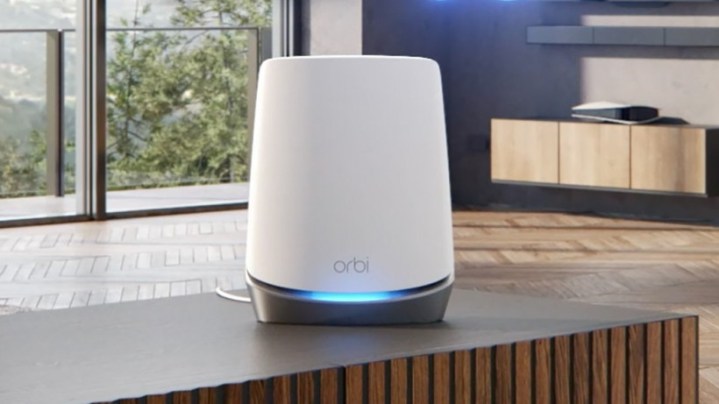
If you have a really fast internet connection in the Gigabit range, then you’ll want a high-end mesh router system like the NETGEAR Orbi, which can handle up to 4,200 Gbps across all its bands. It also has an impressive 5,000 square feet of coverage for just two devices, and you could always get the 3-pack which covers up to 7,500 feet if you need a lot more coverage. That said, the 2-pack can only connect up to 40 devices, which is still a lot, but if you plan to add a lot more smart home devices or other things that need internet, that may be a problem.
NETGEAR Nighthawk AXE5700 Tri-Band Mesh Wi-Fi System (3-Pack) — $358 $550 35% off
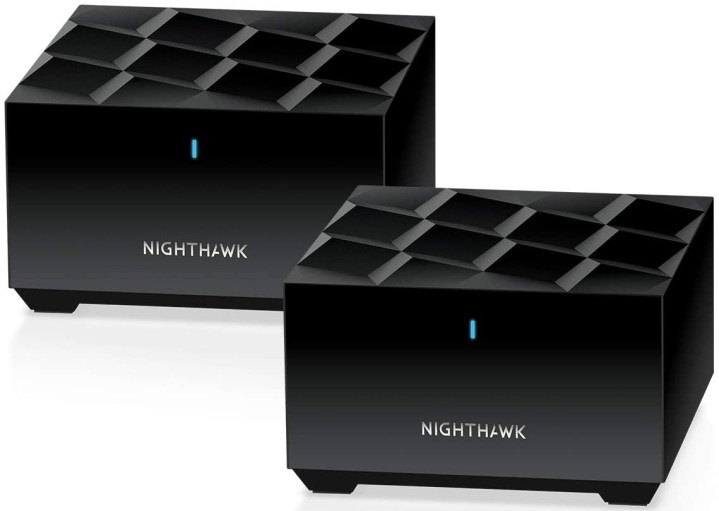
If you have a really large space that you need to cover, this 3-pack of the NETGEAR Nighthawk AXE5700 can handle a space up to 7,500 square feet, as well as a combined speed of 5,700 Gbps, so it’s pretty fast for internal networking needs. They also come with 2.5 Gigabit ethernet ports if you’d like to go for the wired option as well, so there’s a lot of versatility you can take advantage of. The NETGEAR Nighthawk AXE5700 can also handle connecting up to 100 devices, which is a lot, although it would have been nice if it could match the TP-Link Deco X20 for this price point.
How to Choose the Right Router
When it comes to picking a router, the most important thing to focus on is what sort of speeds you’re expecting to get. On most routers or mesh systems, you’ll notice the term ‘AX’ followed by a set of numbers, which signifies its top speeds in megabits per second. Now, in reality, if you’re connecting through an ethernet cable, it won’t really matter what speeds you get since very few homes actually hit or go above 1,000 Mbps. Instead, where this number makes a difference is in the wireless connection since the faster it can go wirelessly, the further it can reach, at least in theory. The big problem is that AX number tends to be the combined speed of all frequencies or antennas, so it can be a bit of a difficult system to decipher. That said, it’s a good rule of thumb when shopping, and then when you find something you like, go in and check the actual speeds for each band, 2.4Ghz and 5Ghz, and what sort of speeds it can deliver.
Another thing to consider is the sort of technology it has under the hood. For example, as mentioned earlier, if you’re buying a new router, you really should opt for Wi-Fi 6 or the newer Wi-Fi 6e, although the latter might be a bit harder to find. You should also check for things like MU-MIMO, a connectivity tech that allows several devices to connect simultaneously without impacting the speeds or quality of the internet.
Technology
HONOR Magic V3 vs Samsung Galaxy Z Fold 6
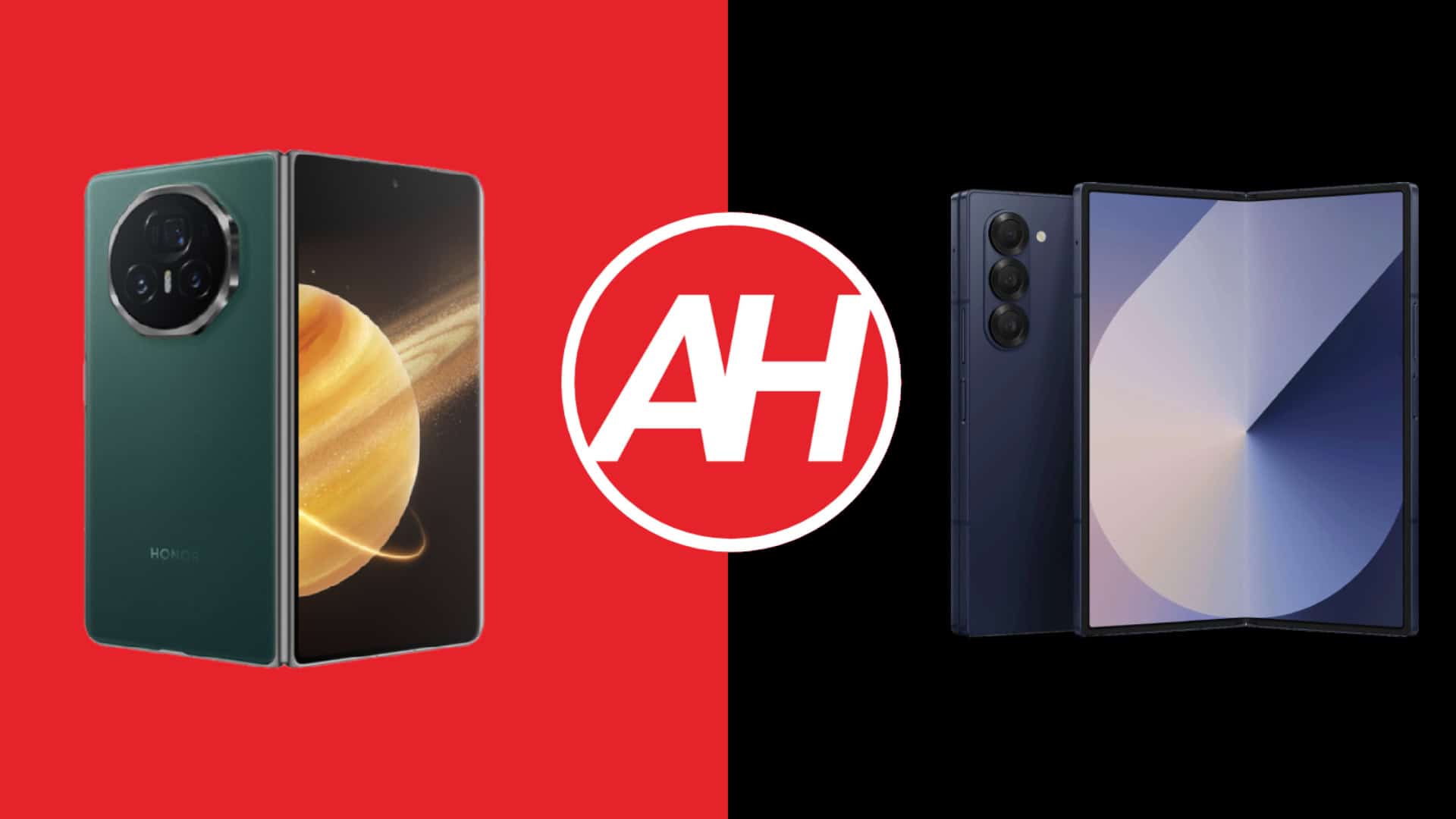
The HONOR Magic V3 is one of the most talked-about foldable smartphones this year. There is a good reason for that. This handset is the thinnest and lightest book-style foldable in the market. It is also available in a number of markets globally. Well, in this article, we’ll compare it with one of the most popular foldable smartphones on the planet. It’s a comparison between the HONOR Magic V3 vs Samsung Galaxy Z Fold 6.
The HONOR Magic V3 launched back in July, while it arrived to global markets in September. The Galaxy Z Fold 6 also arrived in July, only two days before the Magic V3 did. We will first list the specifications of both smartphones and will then move to compare them across a number of sections. That includes design, display, performance, battery, cameras, and audio. Let’s get to it, shall we?
Specs
HONOR Magic V3 & Samsung Galaxy Z Fold 6, respectively
– Screen size (main):
7.92-inch Foldable LTPO AMOLED (120Hz, HDR10+, Dolby Vision, 1,800 nits)
7.6-inch Foldable Dynamic LTPO AMOLED 2X display (120Hz, HDR10+, 2,600 nits)
– Screen Size (cover):
6.43-inch LTPO OLED (120Hz, 5,000 nits)
6.3-inch Dynamic LTPO AMOLED 2X (120Hz, 1,600 nits)
– Display resolution (main):
2156 x 2344
1856 x 2160
– Display resolution (cover):
2376 x 1060
2376 x 968
– SoC:
Qualcomm Snapdragon 8 Gen 3
Qualcomm Snapdragon 8 Gen 3 for Galaxy
– RAM:
12GB/16GB (LPDDR5X)
12GB (LPDDR5X)
– Storage:
256GB/512GB/1TB (UFS 4.0)
– Rear cameras:
50MP (wide, f/1.6 aperture, 1/1.56-inch sensor size, OIS, PDAF), 40MP (ultrawide, f/2.2 aperture, 112-degree FoV), 50MP (periscope telephoto, 1/2.51-inch sensor size, OIS, 3.5x optical zoom)
50MP (wide, f/1.8 aperture, Dual Pixel PDAF OIS), 12MP (ultrawide, 123-degree FoV), 10MP (telephoto, 3x optical zoom)
– Front cameras:
20MP (main display, f/2.2 aperture), 32MP (cover display, f/2.4 aperture)
4MP (under display, main display, f/1.8 aperture), 10MP (cover display, f/2.2 aperture)
– Battery:
5,150mAh
4,400mAh
– Charging:
66W wired, 50W wireless, 5W reverse wired (charger included)
25W wired, 15W wireless, 4.5W reverse wireless (no charger)
– Dimensions (unfolded):
156.6 x 145.3 x 4.35 mm or 4.4 mm
158.7 x 139.7 x 5.8mm
– Dimensions (folded):
156.6 x 74.0 x 9.2 mm or 9.3 mm
153.5 x 68.1 x 12.1 mm
– Weight:
226/230 grams
239 grams
– Connectivity:
5G, LTE, NFC, Wi-Fi, USB Type-C, Bluetooth 5.3
– Security:
Side-facing fingerprint scanner
– OS:
Android 14 with MagicOS 8.0.1
Android 14 with One UI 6.1.1
– Price:
€1,999
$1,699
– Buy:
HONOR Magic V3 (HONOR)
Galaxy Z Fold 6 (Samsung / Best Buy)
HONOR Magic V3 vs Samsung Galaxy Z Fold 6: Design
Both of these smartphones are made out of metal and glass. The thing is, one of the Magic V3 colors does come with a vegan leather backplate, one of three, its orange model. That is also the phone’s lightest and thinnest model, the glass variant is slightly thicker and heavier. The HONOR Magic V3 measures only 4.35/4.4mm when unfolded, and 9.2/9.3mm when folded, while it weighs 226/230 grams. The Galaxy Z Fold 6 measures 5.6mm when unfolded, 12.1mm when folded, and weighs 239 grams.
The difference here is more than apparent on paper, and it’s easily noticeable when you actually hold the devices. The HONOR Magic V3 feels like a regular smartphone in the hand, while the Galaxy Z Fold 6 most certainly does not. The Galaxy Z Fold 6 has flat sides, and it’s more body too. HONOR opted for more curves, which also helps with making it feel like a regular phone. Both devices have cover displays with a centered display camera hole. Both of them also include a fingerprint scanner in the power/lock button.
On the main display of the HONOR Magic V3, you’ll find a display camera hole. The Galaxy Z Fold 6 hides its camera under the main display. HONOR’s handset has a camera oreo on the back. There are three cameras on the inside. The Galaxy Z Fold 6 has three vertically-aligned camera on the back, in the top-left corner. The backplate on the Magic V3 does curve towards the edges, the same cannot be said for the Galaxy Z Fold 6’s.
HONOR’s handset comes with an IPX8 certification for water resistance. The Galaxy Z Fold 6 offers IP48 water resistance. HONOR trumps Samsung in this regard. Both phones do offer stylus support, by the way. Glass variants of both devices are quite slippery. The vegan leather variant of the Magic V3 does add much-needed grip to the equation.
HONOR Magic V3 vs Samsung Galaxy Z Fold 6: Display
The HONOR Magic V3 includes a 7.92-inch 2156 x 2344 Foldable LTPO AMOLED display. That’s its main display, and it can project up to 1 billion colors. HDR10+ content is also supported, as is Dolby Vision. This display’s refresh rate goes up to 120Hz, and the peak brightness is 1,800 nits. The screen-to-body ratio is around 88&. The cover display measures 6.43 inches, and it has a resolution of 2376 x 1080. That’s an LTPO OLED display, and it also can project up to 1 billion colors. Its refresh rate goes up to 120Hz, and Dolby Vision support is included. The peak brightness here is 5,000 nits, in theory.

Samsung’s foldable, on the other hand, has a 7.6-inch Foldable Dynamic LTPO AMOLED 2X main display. That panel also has a refresh rate of up to 120Hz and HDR10+ support. It goes up to 2,600 nits in terms of brightness, and the screen-to-body ratio is around 91%. The resolution here is 1856 x 2160. The cover display, on the other hand, measures 6.3 inches and has a resolution of 2376 x 968. That’s a Dynamic LTPO AMOLED 2X panel with a 120Hz refresh rate and a peak brightness of 2,600 nits. The Gorilla Glass Victus 2 protects this panel.
The displays on the two phones do have slightly different color tuning, but you can alter that in the settings. The point is, all four panels are great. They’re not only vivid and sharp, but they offer great viewing angles too. The touch response is good on all of them as well. The Magic V3 does have an edge in terms of high-frequency PWM dimming, a major advantage. So if you are amongst the people sensitive to it, you should definitely note this difference. If not, both smartphones will serve you just fine in terms of display quality.
HONOR Magic V3 vs Samsung Galaxy Z Fold 6: Performance
The HONOR Magic V3 is fueled by the Snapdragon 8 Gen 3 SoC, Qualcomm’s 3nm processor. That chip is paired with up to 16GB of LPDDR5X RAM and UFS 4.0 flash storage. The Galaxy Z Fold 6, on the other hand, comes with the Snapdragon 8 Gen 3 for Galaxy. That’s the same chip as the one the Magic V3 uses, but it’s overclocked. Samsung also includes 12GB of LPDDR5X RAM in its phone, along with UFS 4.0 flash storage.
Needless to say, both of these phones are immensely powerful, and that does reflect on performance. Both companies did a good job of adapting their software to work well with the provided hardware. They are different on the software side of things, but both phones fly through everyday tasks. Getting either phone to slow down is a chore, to say the least. Regardless of whether we’re talking about opening apps, multitasking, media consumption, or something else entirely,
Gaming in particular is really good on both phones. They can both run basically any game you can think of, and do a great job while doing it… on high graphical settings. There is not lag to talk about, and even though they both do get warm, they never got too warm for us, let alone to hot to hold or anything like that.
HONOR Magic V3 vs Samsung Galaxy Z Fold 6: Battery
You’ll find a 5,150mAh battery inside the HONOR Magic V3. The Samsung Galaxy Z Fold 6, on the other hand, has a 4,400mAh battery on the inside. Needless to say, on paper, HONOR did a much better job here. The company used a silicon-carbon battery too, which is what allowed it to use such a high capacity. So not only does it have a battery with much more capacity, but it’s considerably lighter and thinner.
Does this battery capacity advantage reflect on actual battery life, though? Well, yes, but not as much as you’d think. Both phones can last most people a whole day and even get rather high screen-on-time, depending on your usage. But you can also end up with around 5.5-6 hours of screen-on-time, or lower. It all depends on your usage. The point is, the difference is not nowhere near what the battery capacity indicates. The Galaxy Z Fold 6 did do worse for us, but only barely.
In terms of charging, the Magic V3 easily shames the Galaxy Z Fold 6. It supports 66W wired, 50W wireless, and 5W reverse wired charging. The Galaxy Z Fold 6 supports 25W wired, 15W wireless, and 4.5W reverse wireless charging. Do note that the Magic V3 also includes a charger in the box, while the Galaxy Z Fold 6 does not.
HONOR Magic V3 vs Samsung Galaxy Z Fold 6: Cameras
Each of these phones has three cameras on the back. The HONOR Magic V3 includes a 50-megapixel main camera (1/1.56-inch sensor, f/1.6 aperture), a 40-megapixel ultrawide unit (112-degree FoV), and a 50-megapixel periscope telephoto camera (3.5x optical zoom, 1/2.51-inch sensor). The Galaxy Z Fold 6 has a 50-megapixel main camera (1/1.56-inch sensor, f/1.8 aperture), a 12-megapixel ultrawide unit (123-degree FoV), and a 10-megapixel telephoto camera (3x optical zoom).

Neither of these two phones is the best smartphone camera on the market. Many would say the same for their ranking amongst foldable smartphones, and so would we. However, both phones do offer good cameras. The HONOR Magic V3 is our preferred shooter between the two, though. Its pictures usually looked a bit more lifelike without getting kind of obvious oversharpening and oversaturation effects. That’s something that the Galaxy Z Fold 6 tends to do in certain conditions.
We also preferred the Magic V3 shots in low light, even though both phones did a good job. Both of them like to provide rather bright shots in low light, for better or worse. The ultrawide camera on the Magic V3 is easily the better of the two, and the same goes for its periscope telephoto camera. The telephoto camera on the Galaxy Z Fold 6 is limited in a number of ways. Not only is the sensor size rather small, but it’s a regular telephoto shooter.
Audio
Both of these phones do include stereo speakers. The ones on the Galaxy Z Fold 6 are noticeably louder, though the ones on the Magic V3 are not exactly dim. We were perfectly happy with their perforamnce. Also, both phones offer good and balanced sound output.
What you will not find on either phone is an audio jack. Each of them does have a Type-C port, though, so you can use that to connect your wired headphones. If you prefer wireless connectivity, Bluetooth 5.3 is included on both phones.
Technology
Netflix and TED are hopping on the daily word game bandwagon
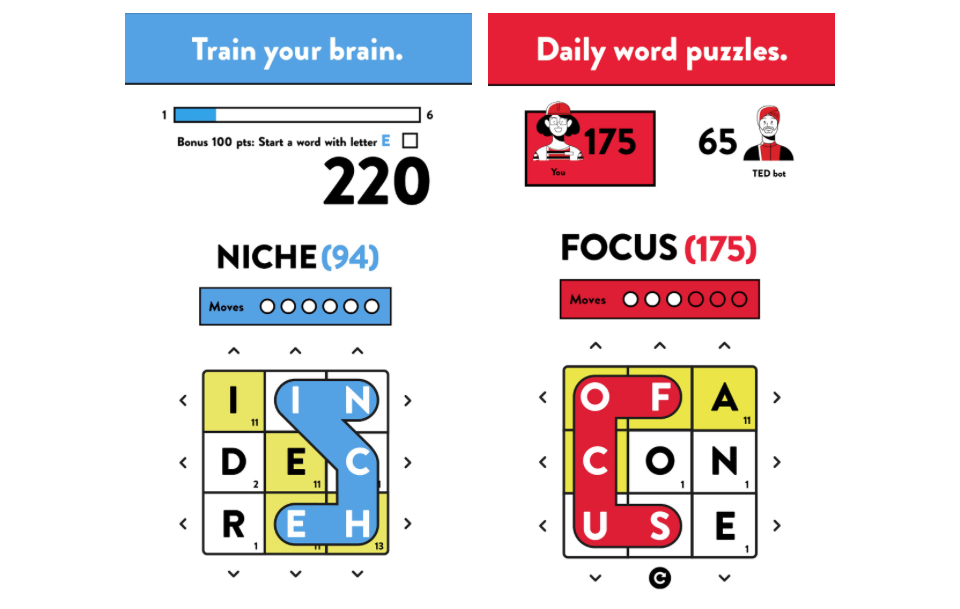
Netflix announced the next addition to its gaming roster, and it’s a collaboration with the TED nonprofit. TED Tumblewords is a daily puzzle game where you slide rows of letters around to make words. There will be three puzzles available each day, and you can play rounds against friends, other online players or the TED bot. In addition to the daily word challenges, which are designed to improve critical thinking and vocabulary, players will see interesting facts from the TED library. The game will be available to play on Netflix and TED.com on November 19.
Since it began offering mobile games, Netflix has amassed a lot of high-quality titles in its lineup. The collection is a mix of licensed indie game projects, such as Hades and Kentucky Route Zero, alongside in-house creations centered on its popular shows, like the retro-styled Stranger Things game. However, the streaming service just today shut down its in-house AAA game studio before the team ever released or even announced a single project. While we wait for TED Tumblewords to arrive, here are some other excellent choices for your daily online gaming fix.
Technology
Cohere adds vision to its RAG search capabilities

Join our daily and weekly newsletters for the latest updates and exclusive content on industry-leading AI coverage. Learn More
Cohere has added multimodal embeddings to its search model, allowing users to deploy images to RAG-style enterprise search.
Embed 3, which emerged last year, uses embedding models that transform data into numerical representations. Embeddings have become crucial in retrieval augmented generation (RAG) because enterprises can make embeddings of their documents that the model can then compare to get the information requested by the prompt.
Your search can see now.
We’re excited to release fully multimodal embeddings for folks to start building with! pic.twitter.com/Zdj70B07zJ
— Aidan Gomez (@aidangomez) October 22, 2024
The new multimodal version can generate embeddings in both images and texts. Cohere claims Embed 3 is “now the most generally capable multimodal embedding model on the market.” Aidan Gonzales, Cohere co-founder and CEO, posted a graph on X showing performance improvements in image search with Embed 3.
The image-search performance of the model across a range of categories is quite compelling. Substantial lifts across nearly all categories considered. pic.twitter.com/6oZ3M6u0V0— Aidan Gomez (@aidangomez) October 22, 2024
“This advancement enables enterprises to unlock real value from their vast amount of data stored in images,” Cohere said in a blog post. “Businesses can now build systems that accurately and quickly search important multimodal assets such as complex reports, product catalogs and design files to boost workforce productivity.”
Cohere said a more multimodal focus expands the volume of data enterprises can access through an RAG search. Many organizations often limit RAG searches to structured and unstructured text despite having multiple file formats in their data libraries. Customers can now bring in more charts, graphs, product images, and design templates.
Performance improvements
Cohere said encoders in Embed 3 “share a unified latent space,” allowing users to include both images and text in a database. Some methods of image embedding often require maintaining a separate database for images and text. The company said this method leads to better-mixed modality searches.
According to the company, “Other models tend to cluster text and image data into separate areas, which leads to weak search results that are biased toward text-only data. Embed 3, on the other hand, prioritizes the meaning behind the data without biasing towards a specific modality.”
Embed 3 is available in more than 100 languages.
Cohere said multimodal Embed 3 is now available on its platform and Amazon SageMaker.
Playing catch up
Many consumers are fast becoming familiar with multimodal search, thanks to the introduction of image-based search in platforms like Google and chat interfaces like ChatGPT. As individual users get used to looking for information from pictures, it makes sense that they would want to get the same experience in their working life.
Enterprises have begun seeing this benefit, too, as other companies that offer embedding models provide some multimodal options. Some model developers, like Google and OpenAI, offer some type of multimodal embedding. Other open-source models can also facilitate embeddings for images and other modalities. The fight is now on the multimodal embeddings model that can perform at the speed, accuracy and security enterprises demand.
Cohere, which was founded by some of the researchers responsible for the Transformer model (Gomez is one of the writers of the famous “Attention is all you need” paper), has struggled to be top of mind for many in the enterprise space. It updated its APIs in September to allow customers to switch from competitor models to Cohere models easily. At the time, Cohere had said the move was to align itself with industry standards where customers often toggle between models.
Source link
Technology
Best Fitbit fitness trackers and watches in 2024

That said, this is a transitional period from the Fitbit of old to whatever Fitbit will be in the future. 2023, in particular, was a messy year. There were multiple Fitbit server outages. I wasn’t impressed with the decision to sunset legacy community features like challenges or the fact that all Fitbit accounts will require you to log in via Google by 2025. Speaking of which, the Fitbit-to-Google account migration started last summer and is required if you buy new products like the Fitbit Charge 6 or Google Pixel Watch 3. The Fitbit app also got a new, more Google-like makeover, which didn’t go over well with many users. (Google has since made adjustments based on feedback.) And in January, much of Fitbit’s leadership, including co-founders James Park and Eric Friedman, left the company as roughly a thousand Google employees were laid off.
You can look at how Google has handled the Nest acquisition as a road map to how things are going. The Googlefication of Fitbit will continue, but there are reasons to stick with its trackers in the meantime. Fitbit trackers are relatively affordable, especially since they often go on sale. All the devices also come with a free trial to Fitbit Premium, the company’s subscription service that adds guided workouts, meditations, and access to more in-depth metrics. So far, it appears Google takes its Pixel Watch lineup seriously, too. With the Pixel Watch 2, the company has expanded extended warranty access and improved replacement options. You just have to go in with eyes wide open.
Best Fitbit smartwatch
The existence of the Pixel Watch, now in its third generation, has thrown a wrench into Fitbit’s smartwatch lineup. Technically, it’s a Google product, but Google owns Fitbit, so they’re all Google products now. Fitbit powers all of the Pixel Watch’s health and fitness features. But really, this is the smartwatch that Fitbit never could manage to build on its own.
The Pixel Watch 3 is a significant update over its predecessors. It finally feels like Google’s no longer playing catch-up to its rivals. This year, the screens are brighter, the bezels are smaller, and there’s now a 45mm size for larger wrists. The larger size doesn’t look chunky, either. Internally, the processor and health sensors are the same as last year, though the third-gen device has an ultra wideband chip that allows you to unlock Pixel phones and some BMW car models.
It’s got the same beautiful design with a circular domed display that looks way more elegant than the squircle Versa or Sense smartwatches ever did. On your wrist, it looks like a watch, not a tracker dressed up as one. The display is a bit fragile for our taste, but as of last year, you can get a Preferred Care extended warranty in the US and Canada. This is one reason we recommend the Pixel Watch 3 over the original since at least you have a more affordable fallback should something happen to your display. Google also announced an option where you can skip customer support and mail in broken, out-of-warranty Pixel Watch devices for discounted replacements.
As for fitness features, the Pixel Watch 3 is much better for runners than it used to be. It includes a new running dashboard, advanced form analytics, custom running workouts, and even AI-generated workout suggestions. It’s also introduced a new metric called Cardio Load, which measures the intensity of your workouts and suggests a target based on your fitness goals. It’s conceptually similar to Garmin’s Training Load. The Daily Readiness Score has also been revamped and is no longer locked behind the Fitbit Premium paywall. On the health front, European users now have Loss of Pulse. If the watch detects you’ve lost your pulse, it’ll call emergency services on your behalf. The feature isn’t available yet in the US, though, as FDA clearance is still pending.
Additionally, Google has strengthened the watch’s integrations with its own services as well as other Pixel devices. For instance, you have offline Google Maps and a Google Home Tile. You can view your Nest Doorbell camera feed or control your Google TV from your wrist, and there’s also the option to record audio with the Recorder app and transfer it to your phone. With Call Assist, you can use your watch to tell anyone calling you need an extra second to pick up the phone.
If all you want is a fitness tracker that looks like a smartwatch, you can consider the $229 Versa 4 since it’s the more budget-friendly option. But there’s no real point in the Sense 2 since the Pixel Watch 3 can do all the same things — and more.
Best budget Fitbit
The Inspire line hasn’t always felt, well, inspired. But the $99.95 Inspire 3 is different. With a color OLED display, it’s reminiscent of the Fitbit Luxe (formerly $149.95, now often around $99.99), just with a matte black plastic case instead of a metal one. It’s a great throwback to classic Fitbits for people who only want the basics.
The Inspire 3 doesn’t overcomplicate things. It’s a fitness band. You won’t get built-in GPS, contactless payments, or digital assistants. Still, what it lacks in smarts it makes up for with Fitbit’s advanced sleep tracking, stress management features, and irregular heart rate notifications. The OLED display is also a step up from the Inspire 2’s monochrome screen, and you still get 10 days of battery life. (Though it’s more like two to three if you enable the always-on display.)
The Inspire 3 has a variety of accessories, including a clip attachment if you want to discreetly track steps. There’s even a gold or silver mesh strap if you want to dress it up a bit.
To be honest, the Inspire 3 and Luxe are quite similar, and they’re often around the same price. It’ll boil down to whether you think the Luxe’s nicer case is worth trading half the battery life for — the Luxe gets an estimated five days instead of 10.
Best Fitbit fitness tracker
The Charge series has always been popular, and the $159.95 Charge 6 is no exception. It’s Fitbit’s higher-end fitness band but easily competes with the more expensive Versa 4 on features. It features a color OLED screen plus an EKG and EDA sensor. You also get built-in GPS, NFC payments, and SpO2 sensors — the only thing you’re really missing is a digital assistant.
The only qualm we have with the Charge 6 is the always-on display. While it’s beautiful, it’s a major battery drain. The Charge 6 has an estimated seven days of battery life, but that dwindles down to about two if you have the always-on display enabled. This is the same issue that we had with the Charge 5, but it’s fairly typical from Fitbit trackers these days.
Altogether, though, you’re getting a hell of a lot for the price. It’s the only FDA-cleared EKG wearable you can find for under $200, and the only other Fitbits capable of EKG and EDA readings are the Sense, Sense 2, and the Pixel Watch 2. So unless you’re dead set on the smartwatch form factor, the Charge 6 is the better overall deal.
Compared to its predecessor, the Charge 6 also adds an improved heart rate algorithm, Bluetooth compatibility with some gym equipment, and a few apps — namely Google Maps, Google Wallet, and YouTube Music. While YouTube Music works well, I’m not stoked that it requires an additional $11 monthly subscription. That said, it’s better than nothing, as Fitbit discontinued onboard music a while back.
In terms of hardware, the Charge 6 also features a haptic button instead of an inductive groove. It’s not a physical button, which is a little disappointing, but it’s more reliable thus far than the inductive groove, so I would count this as a net positive.
You could technically get the Charge 5 at a discount. However, I’d only do that if it’s significantly cheaper and price is your main consideration. The haptic button, while not what I wanted, is far better than the inductive groove and you have more app options. Turn-by-turn navigation is also handy for walks, and it at least offers some form of music playback.
Best Fitbit for kids
That pretty much covers the current Fitbit lineup. The only one we haven’t touched thus far — and the only one that I haven’t tested myself — is the $79.95 Ace 3. That’s Fitbit’s tracker for kids. It’s a basic tracker with a rugged bumper and comes with parental controls. It’s got better battery life than its predecessor but doesn’t come with GPS. Also, while it does have heart rate sensors, it’s not a metric that’s actively tracked for children. Instead, it determines how many “active minutes” they’re getting. Overall, it’s a decent choice for parents whose main priority is making sure their kids get enough daily exercise.
However, Fitbit recently announced the $229.95 Ace LTE. It’s substantially more expensive, but that’s understandable given it’s a significant upgrade in terms of hardware and software. For starters, it has the same guts as the Pixel Watch 2. (The chargers are also compatible!) It also adds built-in LTE for a $9.99 monthly subscription via the Ace Pass, which enables calling, messaging, and real-time GPS tracking for parents. Kids won’t need to have their own smartphone to set it up, and there are no third-party apps or ads on the device. Everything is also controlled via the separate Fitbit Ace app, which works on both iOS and Android.
To encourage more activity, the Ace LTE uses a series of 3D games. After playing a bit, they’re encouraged to get some physical activity to unlock more playing time. There’s also a Tamagotchi-like element, but aside from $35 collectible bands, there are no microtransactions within the games involving real money. (Kids can “buy” more items by completing daily quests and partaking in activities.) As for privacy, Google says that only parents will be able to view location and activity data for children. Location data is deleted after 24 hours, while activity data is deleted after 35 days. We haven’t had a chance to fully test the Ace LTE yet, but stay tuned for our forthcoming review.
Should you even buy a Fitbit right now?
Fitbit officially became part of Google in 2021. Nothing changed overnight, but technically, it’s Fitbit by Google now. The Fitbit-to-Google migration started in earnest in summer 2023 and new users will be asked to log into Fitbit using their Google accounts. In 2025, this will be mandatory for everyone. Last year, Google angered longtime Fitbit users by shuttering longtime social features like Challenges and removing step streaks. (Step streaks have since been added back and expanded to Android.) Meanwhile, the Versa 4 and Sense 2 weren’t as feature-rich at launch compared to their predecessors, leading some to feel that Google purposefully did this to put the spotlight on its Pixel Watch. There were also multiple major server outages in 2023.
There’s some tension here and the future of Fitbit hardware is murky. Especially given the fact that Google laid off about a thousand employees from its hardware departments spanning Pixel, Fitbit, and Nest. If you’re buying a tracker for the first time and want it to last you a while, it might make more sense to opt for a Garmin or Amazfit tracker. Similarly, if you’re looking to upgrade to an older Versa or Sense smartwatch, you might want to see where the dust settles. However, if you know you want a Fitbit, then go ahead. If you’re not in a rush or are undecided, now is not a bad time to sit back and observe.
Update, October 22nd: Adjusted pricing and availability.
-

 Science & Environment1 month ago
Science & Environment1 month agoHyperelastic gel is one of the stretchiest materials known to science
-

 Technology4 weeks ago
Technology4 weeks agoIs sharing your smartphone PIN part of a healthy relationship?
-

 Science & Environment1 month ago
Science & Environment1 month ago‘Running of the bulls’ festival crowds move like charged particles
-

 Science & Environment1 month ago
Science & Environment1 month agoHow to unsnarl a tangle of threads, according to physics
-

 Science & Environment1 month ago
Science & Environment1 month agoMaxwell’s demon charges quantum batteries inside of a quantum computer
-

 Technology1 month ago
Technology1 month agoWould-be reality TV contestants ‘not looking real’
-

 Science & Environment4 weeks ago
Science & Environment4 weeks agoX-rays reveal half-billion-year-old insect ancestor
-

 Science & Environment1 month ago
Science & Environment1 month agoSunlight-trapping device can generate temperatures over 1000°C
-

 Science & Environment1 month ago
Science & Environment1 month agoLiquid crystals could improve quantum communication devices
-

 Science & Environment1 month ago
Science & Environment1 month agoQuantum ‘supersolid’ matter stirred using magnets
-

 Womens Workouts4 weeks ago
Womens Workouts4 weeks ago3 Day Full Body Women’s Dumbbell Only Workout
-

 TV3 weeks ago
TV3 weeks agoসারাদেশে দিনব্যাপী বৃষ্টির পূর্বাভাস; সমুদ্রবন্দরে ৩ নম্বর সংকেত | Weather Today | Jamuna TV
-

 Technology3 weeks ago
Technology3 weeks agoUkraine is using AI to manage the removal of Russian landmines
-

 Science & Environment1 month ago
Science & Environment1 month agoLaser helps turn an electron into a coil of mass and charge
-

 Science & Environment1 month ago
Science & Environment1 month agoWhy this is a golden age for life to thrive across the universe
-

 Science & Environment1 month ago
Science & Environment1 month agoQuantum forces used to automatically assemble tiny device
-

 Science & Environment1 month ago
Science & Environment1 month agoA new kind of experiment at the Large Hadron Collider could unravel quantum reality
-

 Science & Environment1 month ago
Science & Environment1 month agoA slight curve helps rocks make the biggest splash
-

 Science & Environment1 month ago
Science & Environment1 month agoNerve fibres in the brain could generate quantum entanglement
-

 Science & Environment1 month ago
Science & Environment1 month agoHow to wrap your mind around the real multiverse
-

 Football3 weeks ago
Football3 weeks agoRangers & Celtic ready for first SWPL derby showdown
-

 News2 weeks ago
News2 weeks agoNavigating the News Void: Opportunities for Revitalization
-
Business3 weeks ago
DoJ accuses Donald Trump of ‘private criminal effort’ to overturn 2020 election
-

 News3 weeks ago
News3 weeks agoMassive blasts in Beirut after renewed Israeli air strikes
-

 Business3 weeks ago
Business3 weeks agoWhen to tip and when not to tip
-

 News1 month ago
News1 month ago▶️ Hamas in the West Bank: Rising Support and Deadly Attacks You Might Not Know About
-

 Science & Environment1 month ago
Science & Environment1 month agoITER: Is the world’s biggest fusion experiment dead after new delay to 2035?
-

 MMA3 weeks ago
MMA3 weeks agoJulianna Peña trashes Raquel Pennington’s behavior as champ
-

 News2 weeks ago
News2 weeks ago▶ Hamas Spent $1B on Tunnels Instead of Investing in a Future for Gaza’s People
-

 Science & Environment1 month ago
Science & Environment1 month agoTime travel sci-fi novel is a rip-roaringly good thought experiment
-

 News1 month ago
News1 month ago▶️ Media Bias: How They Spin Attack on Hezbollah and Ignore the Reality
-

 Science & Environment1 month ago
Science & Environment1 month agoNuclear fusion experiment overcomes two key operating hurdles
-
News1 month ago
the pick of new debut fiction
-

 Science & Environment1 month ago
Science & Environment1 month agoPhysicists have worked out how to melt any material
-

 News1 month ago
News1 month agoOur millionaire neighbour blocks us from using public footpath & screams at us in street.. it’s like living in a WARZONE – WordupNews
-

 Technology4 weeks ago
Technology4 weeks agoWhy Machines Learn: A clever primer makes sense of what makes AI possible
-

 Technology3 weeks ago
Technology3 weeks agoMicrophone made of atom-thick graphene could be used in smartphones
-

 Technology3 weeks ago
Technology3 weeks agoSamsung Passkeys will work with Samsung’s smart home devices
-

 Sport3 weeks ago
Sport3 weeks agoWales fall to second loss of WXV against Italy
-

 MMA2 weeks ago
MMA2 weeks ago‘Uncrowned queen’ Kayla Harrison tastes blood, wants UFC title run
-

 Sport3 weeks ago
Sport3 weeks agoBoxing: World champion Nick Ball set for Liverpool homecoming against Ronny Rios
-

 MMA3 weeks ago
MMA3 weeks agoPereira vs. Rountree prediction: Champ chases legend status
-

 Technology1 month ago
Technology1 month agoMeta has a major opportunity to win the AI hardware race
-

 Sport3 weeks ago
Sport3 weeks agoWorld’s sexiest referee Claudia Romani shows off incredible figure in animal print bikini on South Beach
-

 MMA3 weeks ago
MMA3 weeks agoDana White’s Contender Series 74 recap, analysis, winner grades
-

 Technology3 weeks ago
Technology3 weeks agoMusk faces SEC questions over X takeover
-

 Sport3 weeks ago
Sport3 weeks agoMan City ask for Premier League season to be DELAYED as Pep Guardiola escalates fixture pile-up row
-

 News3 weeks ago
News3 weeks agoFamily plans to honor hurricane victim using logs from fallen tree that killed him
-

 Sport3 weeks ago
Sport3 weeks agoCoco Gauff stages superb comeback to reach China Open final
-

 Sport3 weeks ago
Sport3 weeks agoSturm Graz: How Austrians ended Red Bull’s title dominance
-

 Technology3 weeks ago
Technology3 weeks agoThis AI video generator can melt, crush, blow up, or turn anything into cake
-

 MMA3 weeks ago
MMA3 weeks agoPereira vs. Rountree preview show live stream
-

 News2 weeks ago
News2 weeks agoHeavy strikes shake Beirut as Israel expands Lebanon campaign
-

 TV2 weeks ago
TV2 weeks agoLove Island star sparks feud rumours as one Islander is missing from glam girls’ night
-

 News3 weeks ago
News3 weeks agoHeartbreaking end to search as body of influencer, 27, found after yacht party shipwreck on ‘Devil’s Throat’ coastline
-
Business3 weeks ago
Sterling slides after Bailey says BoE could be ‘a bit more aggressive’ on rates
-

 News3 weeks ago
News3 weeks agoGerman Car Company Declares Bankruptcy – 200 Employees Lose Their Jobs
-

 News3 weeks ago
News3 weeks ago‘Blacks for Trump’ and Pennsylvania progressives play for undecided voters
-

 Money3 weeks ago
Money3 weeks agoWetherspoons issues update on closures – see the full list of five still at risk and 26 gone for good
-

 Technology3 weeks ago
Technology3 weeks agoThe best budget robot vacuums for 2024
-
Business3 weeks ago
Bank of England warns of ‘future stress’ from hedge fund bets against US Treasuries
-

 Business3 weeks ago
Business3 weeks agoChancellor Rachel Reeves says she needs to raise £20bn. How might she do it?
-

 MMA3 weeks ago
MMA3 weeks agoAlex Pereira faces ‘trap game’ vs. Khalil Rountree
-

 TV3 weeks ago
TV3 weeks agoPhillip Schofield accidentally sets his camp on FIRE after using emergency radio to Channel 5 crew
-

 Technology3 weeks ago
Technology3 weeks agoTexas is suing TikTok for allegedly violating its new child privacy law
-

 Science & Environment1 month ago
Science & Environment1 month agoPhysicists are grappling with their own reproducibility crisis
-

 Science & Environment1 month ago
Science & Environment1 month agoA tale of two mysteries: ghostly neutrinos and the proton decay puzzle
-

 Sport3 weeks ago
Sport3 weeks agoAaron Ramsdale: Southampton goalkeeper left Arsenal for more game time
-

 TV3 weeks ago
TV3 weeks agoMaayavi (මායාවී) | Episode 23 | 02nd October 2024 | Sirasa TV
-

 Technology3 weeks ago
Technology3 weeks agoPopular financial newsletter claims Roblox enables child sexual abuse
-

 Technology3 weeks ago
Technology3 weeks agoOpenAI secured more billions, but there’s still capital left for other startups
-

 News2 weeks ago
News2 weeks agoBalancing India and China Is the Challenge for Sri Lanka’s Dissanayake
-

 Technology3 weeks ago
Technology3 weeks agoEpic Games CEO Tim Sweeney renews blast at ‘gatekeeper’ platform owners
-

 Science & Environment3 weeks ago
Science & Environment3 weeks agoMarkets watch for dangers of further escalation
-

 Football3 weeks ago
Football3 weeks agoSimo Valakari: New St Johnstone boss says Scotland special in his heart
-

 Technology3 weeks ago
Technology3 weeks agoJ.B. Hunt and UP.Labs launch venture lab to build logistics startups
-

 News3 weeks ago
News3 weeks agoWoman who died of cancer ‘was misdiagnosed on phone call with GP’
-

 Technology3 weeks ago
Technology3 weeks agoApple iPhone 16 Plus vs Samsung Galaxy S24+
-

 Entertainment3 weeks ago
Entertainment3 weeks ago“Golden owl” treasure hunt launched decades ago may finally have been solved
-

 News3 weeks ago
News3 weeks agoHull KR 10-8 Warrington Wolves – Robins reach first Super League Grand Final
-

 MMA3 weeks ago
MMA3 weeks agoUFC 307 preview show: Will Alex Pereira’s wild ride continue, or does Khalil Rountree shock the world?
-
Business3 weeks ago
Head of UK Competition Appeal Tribunal to step down after rebuke for serious misconduct
-
Business3 weeks ago
The search for Japan’s ‘lost’ art
-

 Technology3 weeks ago
Technology3 weeks agoHow to disable Google Assistant on your Pixel Watch 3
-

 Technology2 weeks ago
Technology2 weeks agoA very underrated horror movie sequel is streaming on Max
-

 Technology2 weeks ago
Technology2 weeks agoThe best shows on Max (formerly HBO Max) right now
-

 Sport1 month ago
Sport1 month agoJoshua vs Dubois: Chris Eubank Jr says ‘AJ’ could beat Tyson Fury and any other heavyweight in the world
-

 Technology4 weeks ago
Technology4 weeks agoArtificial flavours released by cooking aim to improve lab-grown meat
-
Business4 weeks ago
Eurosceptic Andrej Babiš eyes return to power in Czech Republic
-

 Science & Environment1 month ago
Science & Environment1 month agoCaroline Ellison aims to duck prison sentence for role in FTX collapse
-

 News1 month ago
News1 month agoYou’re a Hypocrite, And So Am I
-

 Science & Environment1 month ago
Science & Environment1 month agoRethinking space and time could let us do away with dark matter
-
News1 month ago
The Project Censored Newsletter – May 2024
-

 Technology4 weeks ago
Technology4 weeks agoQuantum computers may work better when they ignore causality
-

 Technology3 weeks ago
Technology3 weeks agoUniversity examiners fail to spot ChatGPT answers in real-world test
-

 Sport3 weeks ago
Sport3 weeks agoChina Open: Carlos Alcaraz recovers to beat Jannik Sinner in dramatic final
-

 Technology3 weeks ago
Technology3 weeks agoAmazon’s Ring just doubled the price of its alarm monitoring service for grandfathered customers
-

 Health & fitness3 weeks ago
Health & fitness3 weeks agoNHS surgeon who couldn’t find his scalpel cut patient’s chest open with the penknife he used to slice up his lunch
-

 MMA3 weeks ago
MMA3 weeks agoKayla Harrison gets involved in nasty war of words with Julianna Pena and Ketlen Vieira
-

 News3 weeks ago
News3 weeks agoReach CEO Jim Mullen: If government advertises with us, we’ll employ more reporters

You must be logged in to post a comment Login